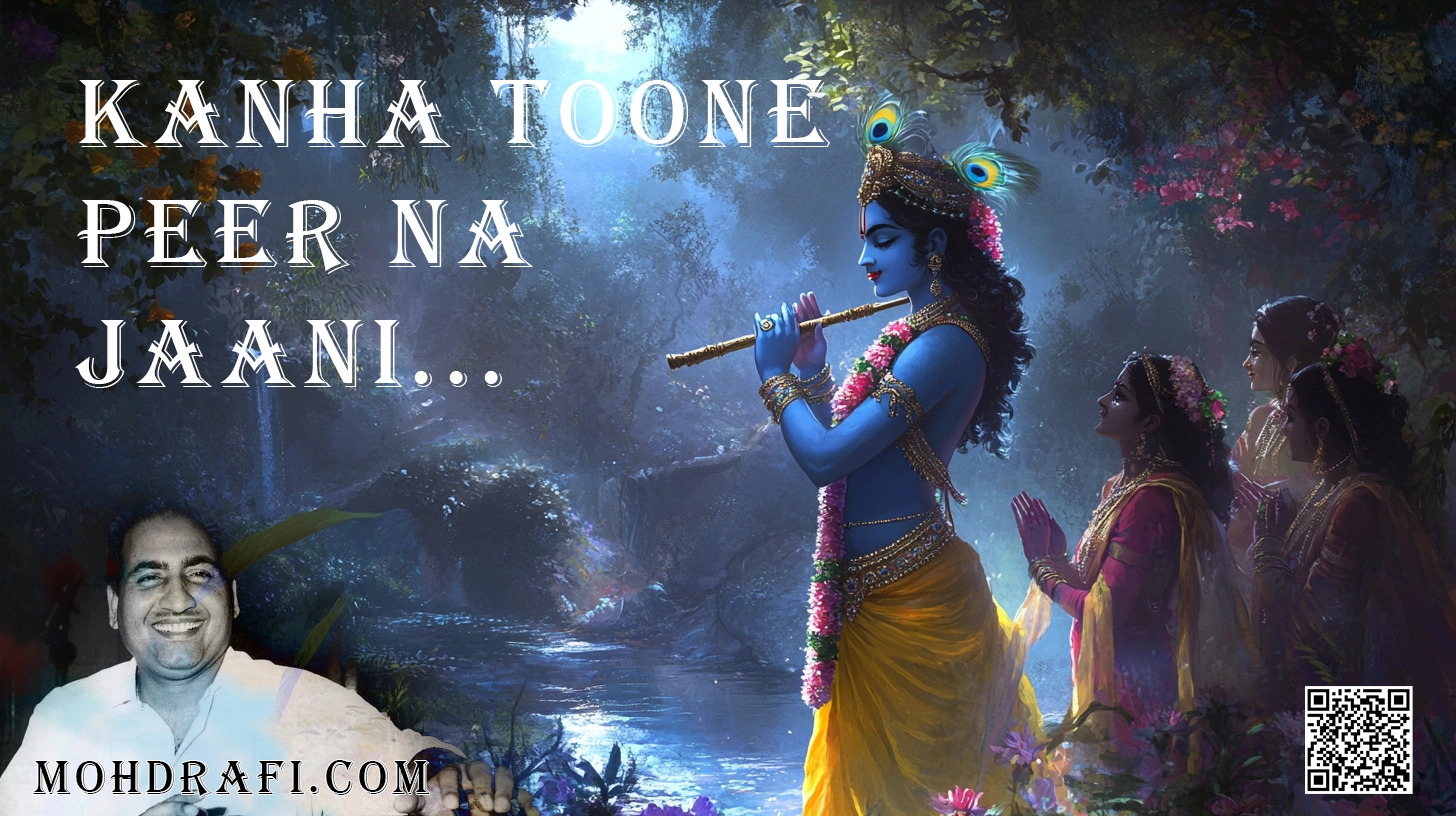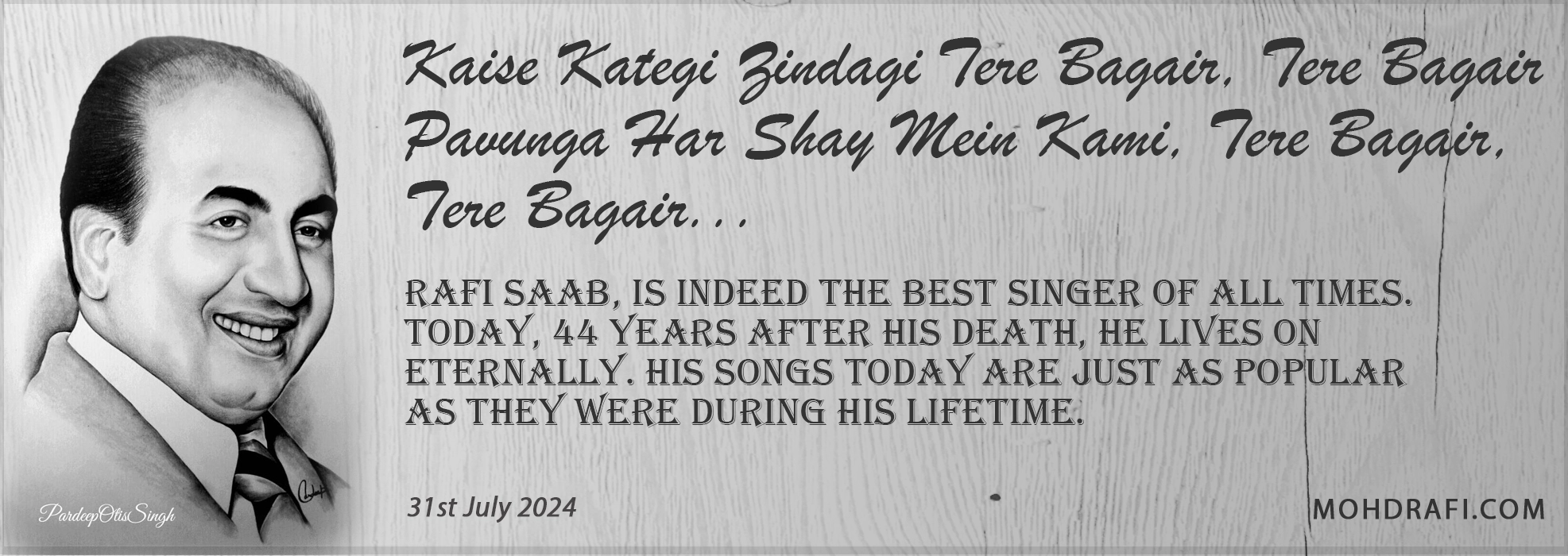Kanha Toone Peer Na Jaani: A Divine Melancholy in Mohammed Rafi Sahab’s Voice
A heart-wrenching devotional song, “Kanha Toone Peer Na Jaani” by Mohammed Rafi captures the deep sorrow of the Gopis as they lament the absence of Lord Krishna.

As a die-hard fan of Mohammed Rafi, I find myself drawn to the soul-stirring melodies that he graced with his golden voice. One such gem is the song “Kanha Toone Peer Na Jaani” from the 1981 album Hari Ka Dhyan Laga Man Mere. Today in India, we are celebrating Krishna Janmashtami, and this song on Lord Krishna is very apt for the day. I wish all the readers a very Happy Krishna Janmashtami!
This devotional song, dedicated to Lord Krishna, is not just a musical offering but an emotional journey that resonates deeply with the heart. The line “Kanha Toone Peer Na Jaani” captures the essence of this devotional piece, which is especially apt as we celebrate Krishna Janmashtami today in India.
In “Kanha Toone Peer Na Jaani,” Mohammed Rafi Sahab’s voice is the perfect vehicle for conveying the deep sense of longing and sorrow felt by the devotees of Lord Krishna. The song beautifully captures the emotional turmoil of the gopis, who are heartbroken by Krishna’s departure.
The plaintive cry of the gopis, expressed through the lyrics, “Bilak Rahe Hein Gwaale-Gwaale, Kaase Kahen Kahaani,” is masterfully rendered by Rafi Sahab, making this song a timeless devotional piece that tugs at the strings of your soul.
In-Depth Analysis and Lyrics Explanation
The song opens with the lines:
कान्हा तूने पीड़ ना जानी, तूने पीड़ ना जानी,
हाय, तूने पीर ना जानी,
बिलक रहे हैं ग्वाले-ग्वाले, कैसे कहें कहानी,
तूने पीड़ ना जानी, हाय, तूने पीड़ ना जानी..
Kanha Toone Peer Na Jaani, Toone Peer Na Jaani,
Haay, Toone Peed Na Jaani,
Bilak Rahe Hein Gwaale-Gwaalin, Kaase Kahen Kahaani,
Toone Peer Na Jaani, Haay, Toone Peer Na Jaani..
This verse sets the tone for the entire song, highlighting the pain and sorrow of Krishna’s devotees. The lyricist, Rajesh Johari, uses simple yet profound words to express the deep anguish of the Gopis. The repetition of the phrase “तूने पीड़ ना जानी” emphasizes the feeling of abandonment and the unfulfilled yearning of the devotees. The use of the word “पीड़” (pain) signifies the depth of the emotional turmoil that the gopis are experiencing, a pain that even Lord Krishna, their beloved, seems unaware of.
As the song progresses, we hear:
पहले नेह लगाया तूने, फिर ये नाथा तोड़ा,
हाय, फिर ये नाथा तोड़ा,
बोल सखा, सखियों को तूने, काहे तड़पता छोड़ा,
काहे तड़पता छोड़ा, तड़पे प्रीत दीवानी,
तूने पीड़ ना जानी, हाय, तूने पीड़ ना जानी..
Pehle Neh Lagaaya Toone , Phir Yeh Naatha Thoda,
Haay, Phir Yeh Naatha Thoda,
Bol Sakha, Sakhiyon Ko Toone, Kaahe Tadapta Chhoda,
Kaahe Tadapta Chhoda, Tadpe Preet Diwani,
Toone Peer Na Jaani, Haay, Toone Peer Na Jaani..
Here, the Gopis lament the broken bond with Lord Krishna. The lyrics poignantly describe how Krishna first established a deep connection with them and then suddenly severed it, leaving them in emotional turmoil. The term “तड़पे प्रीत दीवानी” reflects the intensity of their love and devotion, which has now turned into suffering. Mohammed Rafi Sahab’s delivery of these lines is so evocative that one can almost feel the Gopis’ pain as their voices quiver with sorrow.
The song continues with:
कौन गगरिया फोड़ेगा अब, रास रचाए कौन?,
कन्हैया, रास रचाए कौन?
सूना है, जमुना का टीरा, साधा सब ने मौन,
हाय, साधा सब ने मौन, डसती सांझ सुहानी,
तूने पीड़ ना जानी, हाय, तूने पीड़ ना जानी..
Kaun Gagariya, Phodega Ab, Raas Rachaaye Kaun?,
Kanhaiya, Raas Rachaaye Kaun?
Soona Hai, Jamuna Ka Teera, Saadha Sab Ne Maun,
Haaye, Saadha Sab Ne Maun, Dasti Saanjh Suhani,
Toone Peer Na Jaani, Haay, Toone Peer Na Jaani..
In this stanza, the Gopis mourn the absence of Krishna during the Raas Leela, a dance that symbolizes divine love and unity. The empty banks of the Yamuna, the silent evenings, and the absence of the joyous Raas highlight the void left by Lord Krishna’s departure. The imagery in these lines is vivid and poignant, reflecting the desolation felt by the Gopis. Rafi Sahab’s rendition of “डसती सांझ सुहानी” is particularly haunting, capturing the beauty of the evening that now feels like a snake bite in the absence of Krishna.
The Lyricist and Musician Behind the Masterpiece
Rajesh Johari, the lyricist of “Kanha Toone Peer Na Jaani,” was known for his ability to craft lyrics that were both simple and deeply meaningful. His work often reflected a deep understanding of human emotions and spiritual longing. Other notable songs penned by Rajesh Johari include “Hari Ka Dhyan Laga Man Mere” and “Mere Shyam Tera Naam.”
The music for this song was composed by Pandit Shivram, a maestro known for his devotional compositions. Pandit Shivram had a unique ability to blend classical music with bhajans, creating a sound that was both traditional and accessible. His collaboration with Mohammed Rafi resulted in several timeless pieces, with “Kanha Toone Peer Na Jaani” being one of the most memorable.
Album: Hari Ka Dhyan Laga Man Mere
Year: 1981
Singer: Mohammed Rafi
Lyrics: Rajesh Johari
Music: Pandit Shivram

Post your Comment on Facebook